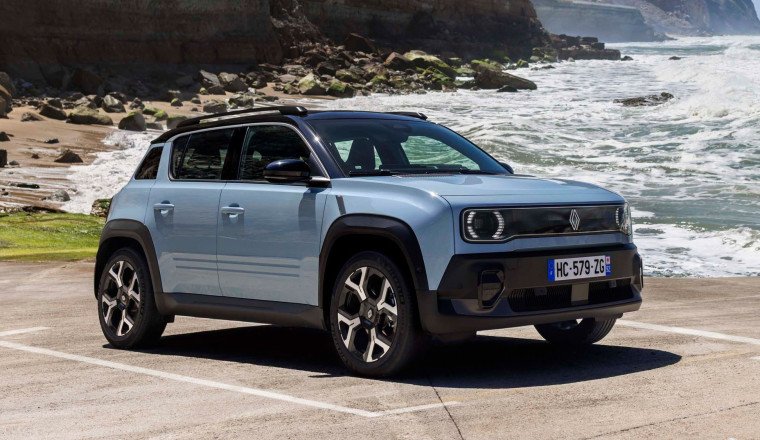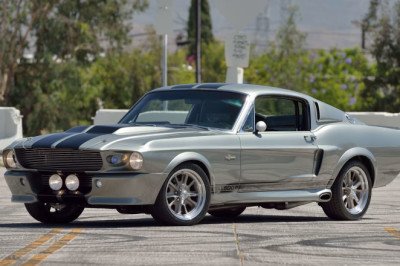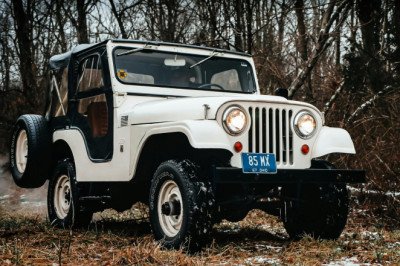
► New Renault 4 E-Tech UK pricing
► Retro-inspired electric family hatch
► Packs in the value from £26,995
The new Renault 4 E-Tech is another electric car that looks to La Regie’s back catalogue for inspiration – while simultaneously squaring up to the future. Like the Renault 5 E-Tech, with which it shares two-thirds of its components, it wraps the hardware of a modish EV in a decidedly retro-inspired wardrobe. And now we know it will be priced from £26,995 when order books open in July 2025.
Curiously, there is a staggered buying process. If you’re prepared to fork out £150 for an ‘R Pass’ you’ll be able to place your Renault 4 order on 1 July. Not quite that desperate to get your mitts on one? Then the ‘general public’ will be allowed to start their purchasing journey on 15 July. £150 to jump the queue by two weeks? Seems a bit ‘dynamic pricing’ cynical at first, but there are other benefits.
R Pass customers also get exclusive access to three years’ free servicing – if they use Renault’s Mobilize Financial Services (MFS) to fund the car. Perhaps more importantly, the latest announcement confirms the three standard trim levels for the UK: Evolution, Techno and Iconic. The optional ‘plein sud’ canvas electric roof for the two higher specifications won’t be available straight away, however.
All models at UK launch get the 148bhp electric drive system with what Renault’s calling the ‘comfort’ driving range. Prices start at £26,995 for the Evolution, with the Techno £2k more at £28,995 and the Iconic £2k more than that at £30,995. For the kit and spec it’s not a bad-looking deal; a Fiat Grande Panda Electric is considerably cheaper at £20,975, while the Hyundai Inster is more spacious for people from £23,505, but these have just 111bhp and 113bhp, respectively.
Standard equipment is generous throughout the Renault 4’s line-up. Highlights for the entry-level Evolution include 18-inch alloy wheels, keyless entry, heated windscreen washer nozzles, dual-zone climate control, 10.0-inch infotainment screen, cruise control, reversing camera and lots of safety gear.
Upgrade to Techno and the infotainment gets Google Maps built in, there’s a wireless phone charger, adaptive cruise control, choice of driving modes, front and side parking sensors (in addition to the standard rear ones), ambient lighting, four-levels of regen via wheel-mounted paddles, roof rails and vehicle-to-load bidirectional charging.
Iconic adds an electric, hands-free boot opening system, height-adjustable front seats (with six-way lumbar adjustment for the driver), and more safety kit, including blindspot monitors and extra adaptive driver assistance. More significantly, it’s the only version that comes with heated front seats and steering wheel, items you can’t add as options to the lesser specifications.
Unveiled at the 2024 Paris motor show, the Renault 4 plays its historic connections less flamboyantly than the 5; that car indulges its lineage more obviously, perhaps, but if you know your twentieth century Renaults you’ll clock the connections to the famous Four in this boxier, more practically-minded hatchback.
There’s the distinctive R4 front grille, reinterpreted in a single-piece snout encompassing an illuminated diamond badge, distinctive light graphics and a light bar that echoes the shape of the original Renault 4 facia. Claimed to be ‘the world’s first one-piece illuminated grille,’ it stretches 1.45m across and illuminations are standard from second-run Techno trim and above.
Other links to the original include the kicked-up C-pillar and side window graphic, the ribbed lower door design and the angle of the rear tailgate, which now extends much lower than on conventional hatchbacks for an admirably low boot floor. These things matter if you’re a dog owner or regularly lug heavy sports equipment into the car.
‘We didn’t want to betray the spirit of the original Renault 4,’ Renault’s vice president of design, Gilles Vidal, told CAR. ‘The Renault 4EVER Trophy show car [above] was the rally-raid version – this is the urban iteration of that. It’s super-practical and we wanted to make sure it could swallow Ikea Billy bookcases but still look cool.’
The new 4 rides on the Renault Group’s AmpR Small architecture, shared with the 5 and upcoming electric Nissan Micra, bringing front-wheel drive and fully independent rear suspension (quite unusual in this class). It will be available with two different battery sizes and motors, largely mirroring the tech found on the latest 5:
Both models can be fast-charged, although at relatively modest speeds. The smaller battery can take onboard DC current at up to 80kW, whereas the 110kW model can charge at up to 100kW – fast enough that either model can replenish their batteries from 15-80% in 30 minutes, according to Renault. A heat pump is standard on every model to aid optimised range and charging in all temperatures.
The company’s battery tech is advancing apace; engineers say the entire battery now weighs less than 300kg and a new way of packaging four large modules in one battery casing saves around 20 kilos compared with a Renault Zoe EV. The smaller battery simply leaves one of the compartments empty.
Bi-directional charging is offered on the new Renault 4 E-Tech. That means you can power electric items such as airbed compressors or a kettle when you’re out in the field – or equally sign up to an energy deal which lets you manage power around your home, shuffling energy from batteries, solar panels and the grid to achieve the greenest, cheapest combination.
The original Renault 4 sold 8.1 million units between 1961-1992, making it one of the most successful cars of its period. Dubbed Quattrelle, after its domestic 4L badge, the boxy silhouette freed up space for people and luggage galore – a trait the designers of the new car have strived to repeat.
It’s only supermini sized, at 4.1m long, 1.8m wide and 1.6m high but some clever packaging has freed up a roomy boot with a 420-litre capacity (including the split underfloor cubby). That’s 100 litres over the smaller 5 hatch. The designers recreated the flat tailgate while the engineers reworked the cross beam on the rear sub-frame to allow a dramatically lower boot floor that’s 10cm lower than any rival. We’ve sat in the boot of the new 2025 Renault 4 and can vouch that the loadbay is significantly lower than any rival we’ve seen: the loading height is a remarkable 60.7cm from the tarmac.
The interior is almost a carbon copy of the 5’s, but with a few distinct touches for more family-focused duty. The rear floor is entirely flat, freeing more room for passengers’ feet, while the Techno spec comes with trim inspired by denim for a hard-working, blue-jeans vibe. This kind of modish charm percolates the 4, with customisable stickers, two-tone roof and steel wheels all available on the extensive options list.
Renault knows it can coin extra margin by offering cool extras these days, especially on a car with a fashionable brief. Other toys available on the options list include a 1m canvas rollback roof made by Webasto which opens by voice command, a baguette holder (initially available only on launch-spec models at a high price, but with a planned roll-out across the board at lower cost) and interchangeable indicator stalks, whose sleeve can be unclicked and swapped with ease.
In fact, Renault claims 670 possible combinations of colour, trims and wheels, making it easy for you to stand out from the crowd. Special mention to the new deliciously retro Hauts-de-France Green of the car in our pictures, a tribute to the Île-de-France Blue of the 1960s. That with steel wheels sounds très sympa…
The cabin of the Renault 4 E-Tech is modish and on trend. Pleasingly, there are enough physical switches so that not everything is operated by a sub-menu on the standard 10in touchscreen. It’s roomy in the front and the quilted headlining is a lovely touch overhead.
Pick your spec carefully, as the character of the car is changed significantly with the denim upholstery option (which extends to the dashboard) and other fabrics. Leather is not available on any model – in line with its sustainable principles: 89% of the R4 can be recycled and around a quarter of its materials are from the circular economy.
CAR has pored all over the newcomer at its Paris show debut and the rear seats are disappointingly tight on space; there is only so much magic they can weave on a car whose footprint extends to just 4.1m long. The 4 and 5 duo have a similar relationship to the Clio/Captur – the 4 is not meant as a fully fledged family car, more a compact crossover vibe to challenge the Mini Countryman. Sitting behind a 6ft adult means less rear legroom and the space for feet is particularly pinched under the front seats.
A clever touch on left-hand drive models is a fully folding front passenger seat which can be cranked forwards to lie pretty flat – so you can carry a surfboard or other bulky item up to 2.2m in length. Disappointingly, this has not been engineered for right-hand drive, denying Brits this feature.
The most basic Renault 4 E-Tech with the smaller battery weighs from 1410kg – an encouraging sign for an electric car. The company has not yet released full performance figures, but claims the more powerful model can sprint from 0-62mph in less than 8.5 seconds, with 50-75mph in less than 7.0sec. Top speed is pegged to 93mph.
Launched in 1961, the Renault 4 – or ‘Quatrelle’ as it was known in France, owing to its 4L badge – was the world’s first mass-produced hatchback. That made it a good load-carrier, especially with deckchair seats that could be removed.
With long-travel independent suspension and front-wheel drive, the 4L proved adept at scrambling over tough terrain, making it the darling of rural France. Even some of us at CAR had a soft spot for the model – Russel Bulgin’s love for the Renault 4 ran deep.
With contributions from
CJ Hubbard Head of the Bauer Digital Automotive Hub
By Phil McNamara and CJ Hubbard















Facebook Conversations